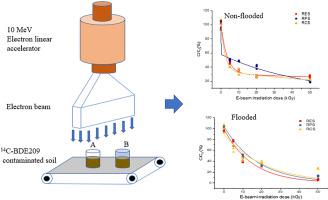Environmental Pollution ( IF 7.6 ) Pub Date : 2021-06-10 , DOI: 10.1016/j.envpol.2021.117564 Pengfei Zhao 1 , Qingfu Ye 2 , Yaoying Zheng 2 , Joann K Whalen 3 , Sufen Zhang 2 , Wei Wang 2

|
Deca-brominated diphenyl ether (BDE-209) is shown to be persistent in soil and it's urgent to find an effective method to remove BDE-209 from contaminated soil. In this study, the investigation of BDE-209 degradation in three different rice-vegetable rotation soils induced by electron beam (E-beam) irradiation under flooded and non-flooded conditions was conducted. The reductive efficiency of 14C-BDE209 reached the highest level at 50 kGy and the values in flooded soils of rice-eggplant rotation soil (RES), rice-peanut soil (RPS), and rice-chili pepper soil (RCS) were 93.5%, 87.2%, and 73.8%, respectively. The reductive efficiencies in non-flooded soils of RES, RPS, and RCS were 73.4%, 81.0%, and 78%, respectively. The D0.5 values (dose required for reducing 50% BDE-209) of BDE-209 in non-flooded soils were lower than those in flooded soils, suggesting greater degradation efficiency of BDE-209 in non-flooded soils than in flooded soils. The BDE-209 was degraded into higher-brominated PBDEs and lower-brominated PBDEs by E-beam irradiation. The results demonstrate that BDE-209 in the soil can be degraded by E-beam irradiation, non-flooded condition is better than flooded condition for the removal of BDE-209, and the main degradation mechanism of BDE-209 by E-beam irradiation is debromination. This study provides a rapid and effective method for degrading BDE-209 that is persistent in soils, and has important implications for the remediation of soil contaminated by PBDEs in and around E-waste dismantling areas.
中文翻译:

电子束辐照诱导水稻-蔬菜轮作土壤中BDE-209的辐射降解
十溴二苯醚 (BDE-209) 在土壤中具有持久性,迫切需要找到一种有效的方法从受污染的土壤中去除 BDE-209。在这项研究中,研究了在淹水和非淹水条件下电子束(E 束)辐照在三种不同的水稻-蔬菜轮作土壤中 BDE-209 的降解情况。14 C-BDE209的还原效率在50 kGy时达到最高水平,在水稻-茄子轮作土壤(RES)、水稻-花生土壤(RPS)和水稻-辣椒土壤(RCS)淹水土壤中的还原效率为93.5 %、87.2% 和 73.8%。RES、RPS和RCS在非淹水土壤中的还原效率分别为73.4%、81.0%和78%。D 0.5非水淹土壤中 BDE-209 的值(减少 50% BDE-209 所需的剂量)低于水淹土壤中的值,表明 BDE-209 在非水淹土壤中的降解效率高于水淹土壤。BDE-209 通过电子束辐照降解为高溴化多溴二苯醚和低溴化多溴二苯醚。结果表明电子束辐照可降解土壤中的BDE-209,非淹水条件对BDE-209的去除效果优于淹水条件,电子束辐照对BDE-209的主要降解机制是脱溴。本研究为降解土壤中持久存在的 BDE-209 提供了一种快速有效的方法,对修复电子废物拆解区及其周围多溴二苯醚污染的土壤具有重要意义。











































 京公网安备 11010802027423号
京公网安备 11010802027423号